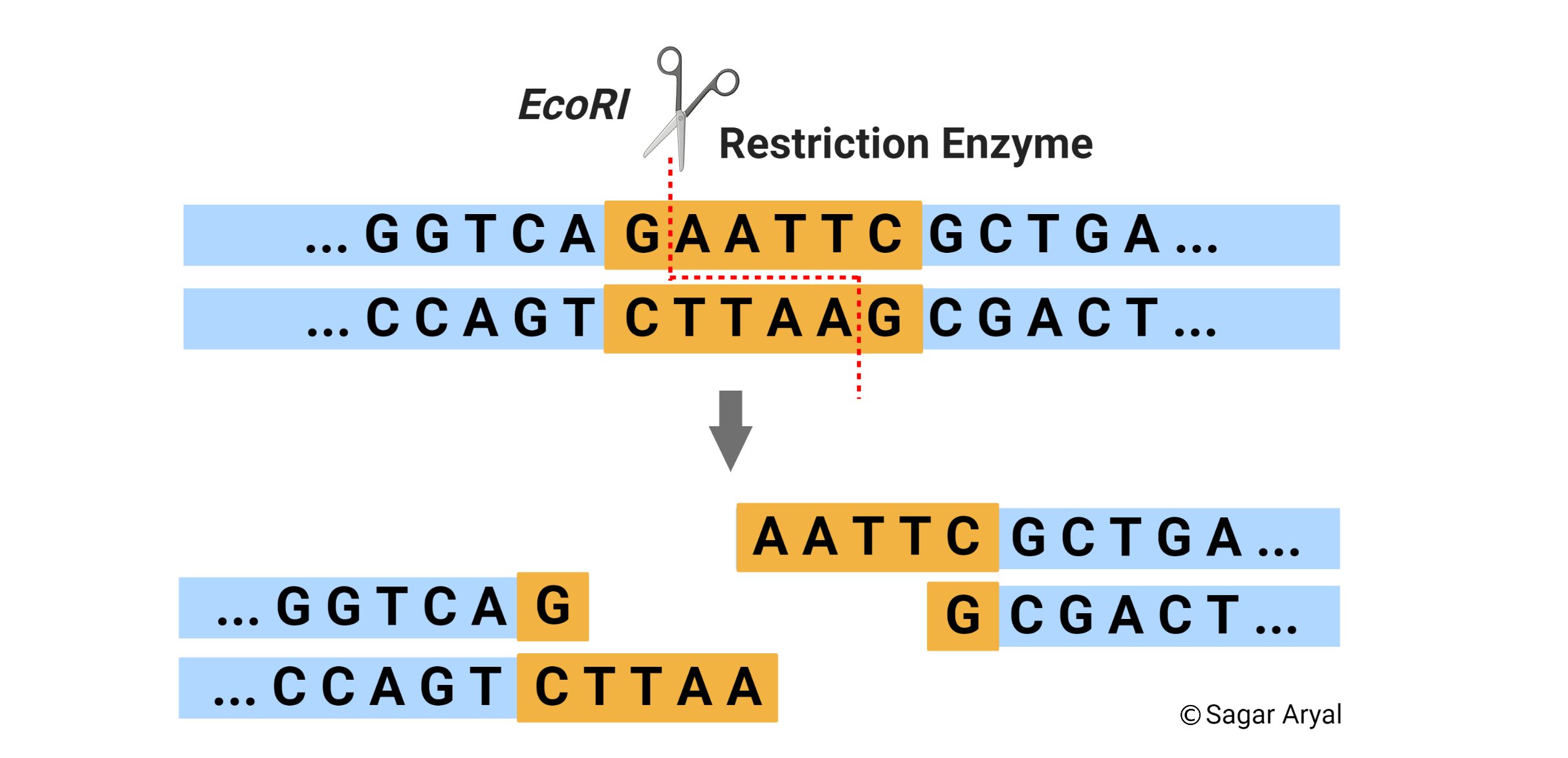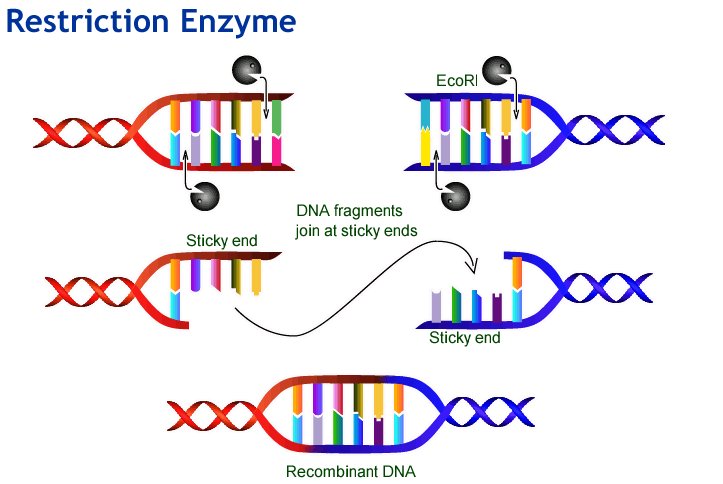Describe How Enzymes Are Used to Cut Dna
Restriction enzymes are DNA-cutting enzymes. This creates DNA fragments with one nucleotide strand that overhangs at the end.
OR 1 make artificial DNA with correct sequence of bases.

. Restriction enzymes are a type of endonucleases that can be used to cut double-stranded DNA at specific regions. They allow researchers to obtain desired DNA fragments from genomic DNA. A restriction enzyme is a DNA-cutting enzyme that recognizes specific sites in DNA.
Explain how restriction enzymes are used to cut and paste DNA into plasmids. 2 and use reverse transcriptase to form desired DNA. Restriction enzymes are used to cut DNA sequences at specific areas.
Coli could use to make HGH. It is joined with DNA ligase. Ligase enzyme is able to join together such cut ends of nucleic acids.
This site is known as the restriction site. Restriction enzymes also known as endonucleases recognize specific sequences of DNA base pairs and cut or chemically separate DNA at that specific arrangement of base pairs. Recombinant DNA generally contains a gene of interest inserted into a vector.
For a list of many commonly used restriction enzymes visit NEB. Restriction enzymes have specific recognition sites. They are often referred to as genetic scissors.
SmaI is an example of a restriction enzyme that cuts straight through the DNA strands creating DNA fragments with a flat or blunt end. For the enzyme cut in a Taster. For the hom-ozygous taster both copies of the gene contain the polymorphism hence allowing to be cut by the enzyme.
So when this restriction enzyme finds that code in your DNA it cuts it. Other restriction enzymes like EcoRI cut through the DNA strands at nucleotides that are not exactly opposite each other. Hence fragments which are produced on the gel at 221bp 177bp and 44bp.
A restriction enzyme makes two incisions through the sugar phosphate backbone of. The restriction enzyme recognises a unique sequence of nucleotides in the DNA strand which is usually between four to six base-pairs in length. However some produce blunt ends.
The specific sequence of. The restriction enzyme is a protein produced by bacteria that cleaves the DNA at specific sites. Restriction enzymes are a special class of proteins that cut DNA at specific sites and have become an indispensable tool in molecular biology.
1- bacteria cell 2-viruses try to attack bacteria. Recognise foreign genetic code prokaryotic organisms use restriction enzymes to identify and cut foreign DNA. They recognize and cleave at the restriction sites of the bacteriophage and destroy its DNA.
The mode of action of a template-dependent DNA polymerase. She made this decision because only methods 2 and 3 would produce DNA that E. Restriction endonucleases are a group of enzymes that can recognise and cut specific sequences of DNA into fragments with sticky ends.
Briefly describe how restriction enzymes gel electrophoresis and PCR are used in DNA fingerprinting 1 See answer Advertisement. Each enzyme recognizes one or a few target sequences and cuts DNA at or near those sequences. Restriction enzymes are endonucleases that cut DNA at specific locations called restriction sites.
If two DNA molecules have matching ends they can be joined by the enzyme DNA ligase. Use DNA ligase to produce recombinant DNA. Coli could use to make HGH.
For an heterozygous taster only half of ones DNA will be cut by the enzyme. To show that I use sickle cell anemia diseases like example and step by step describe how restriction enzymes can to diagnose patients with this disease. They have a nucleotide code on them.
3 cut plasmid open. An enzyme is used to cut out a specific gene and the same enzyme is used to cut open a plasmid. Restriction enzyme digestion is commonly used in molecular.
Restriction enzymes found naturally in bacteria can be used to cut DNA fragments at specific sequences while another enzyme DNA ligase can attach or rejoin DNA fragments with complementary ends. The diagnosis I will. Restriction endonucleases can cut DNA at recognition sequences called restriction sites.
OR 1 use mRNA from oat which will code for resistance. Restriction enzymes are important tools. Each restriction enzyme recognizes and can attach to a certain sequence on DNA called a restriction site.
The figure shows how a restriction enzyme can make a cut in a circular piece of DNA and turn it. An enzyme that synthesizes DNA is called a DNA polymerase and one that copies an existing DNA or RNA molecule is called a template-dependent DNA polymerase. Explain why only methods 2 and 3 would produce DNA that E.
In DNA fingerprinting restriction enzymes can be used to cut DNA to obtain the banding pattern of STR. This recombinant dna is introduced into Ecoli the foreign gene introduced will show same working as in human. Sticky ends of the gene and the plasmid will hydrogen bond.
2 using restriction endonucleaserestriction enzyme. Many restriction enzymes make staggered cuts at or near their recognition sites producing ends with a single-stranded overhang. The restriction enzymes protect the live bacteria from bacteriophages.
AThe geneticist decided not to use restriction enzymes to cut out a fragment of DNA containing the HGH gene from a human genome. Restriction enzymes or to use their correct name restriction endonucleases are a type of enzyme which have the ability to cut molecules of DNA. 1 cut desired gene from DNA of oat plant.
Fragments of 177-bp and 44-bp are then produced. The properties of restriction enzymes can be used to produce recombinant DNA molecules by cutting DNA at precise locations. Restriction enzyme digestion takes advantage of naturally occurring enzymes that cleave DNA at specific sequences.
You can think of restriction enzymes as little molecular scissors that slide along the DNA and cut the sugar-phosphate backbone wherever they find their restriction site. 2 using DNA polymerase. Enzymes can be used to cut up and join DNA pieces together.
Many restriction enzymes make staggered cuts producing ends with single-stranded DNA overhangs. The discovery of enzymes that could cut and paste DNA made genetic engineering possible. Restriction enzymes recognise specific sequences in DNA and cut the DNA at these points DNA Ligase another enzyme is used to join the two pieces of DNA together.
There are hundreds of different restriction enzymes allowing scientists to target a wide variety of recognition sequences. Restriction enzyme is able to cut a DNA double helix in a certain way only at palindromic sequences.

Restriction Enzyme Restriction Endonuclease

Igcse Biology 2017 5 12 Understand How Restriction Enzymes Are Used To Cut Dna At Specific Sites And Ligase Enzymes Are Used To Join Pieces Of Dna Together

Why Are Restriction Enzymes Important For Recombinant Dna Technology Socratic

Comments
Post a Comment